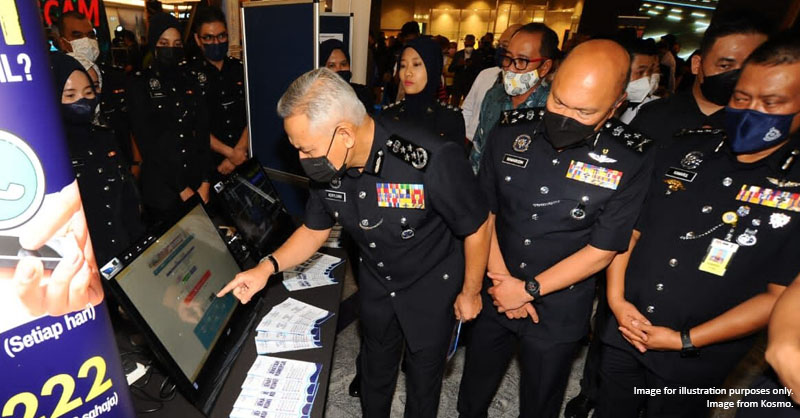Wait, drunk driving is the LOWEST cause of fatal car crashes in Malaysia? We check.
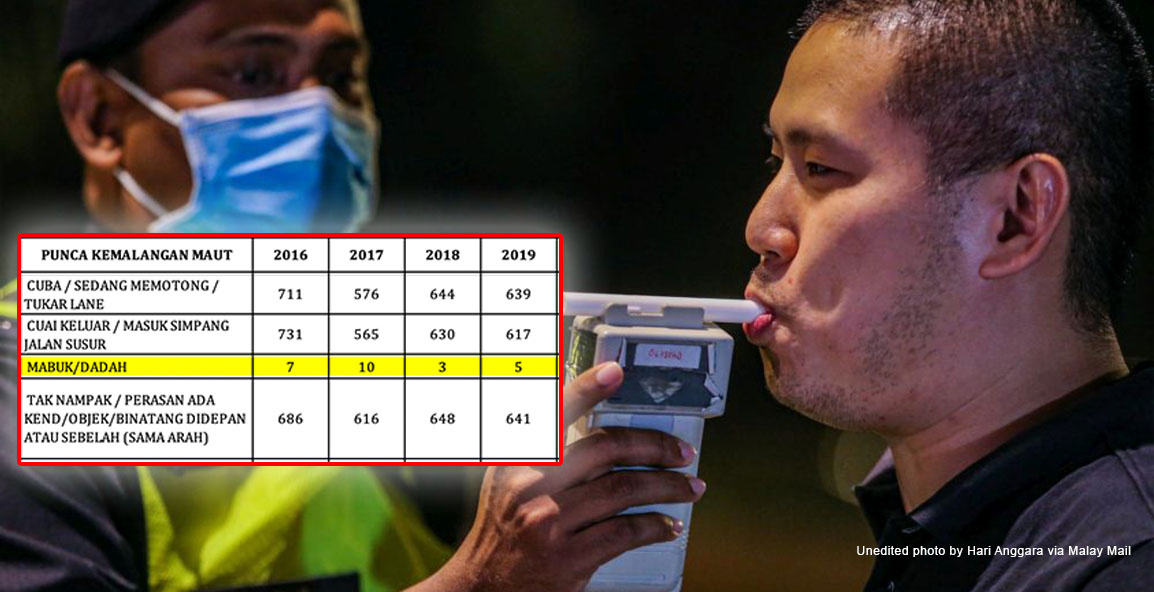
- 15.1KShares
- Facebook15.0K
- Twitter12
- LinkedIn10
- Email40
- WhatsApp103
No matter how you look at it, there are some things in this world that just cannot be combined:
- oil and water
- Apple watches and Android phones
- katanas and dishonored samurai
- alcohol and controlling a moving vehicle
In particular, the last one has been the recent subject of debate when PAS called for a temporary ban on alcohol to prevent drunk driving accidents:
“Considering the frequency of accidents involving drunk drivers, PAS proposes that the government led by Prime Minister Muhyiddin Yassin immediately suspend the production, business and sale of alcohol until all measures have been taken to prevent drunk driving.” – PAS information chief Kamaruzaman Mohamad, as quoted by Malaysiakini
On the surface, it looks like drunk-driving is something that happens super frequently on Malaysian roads, since a few MCO-related headlines involved drunk drivers crashing into police roadblocks – with two happening on the same day in Ampang and Kajang – and a bunch more incidents listed here.
But then there was a screenshot making its rounds on Facebook claiming that the government’s own data showed that deaths caused by drunk driving was so low, they had to be categorized with drugs (drug driving?). We’ll post the full table in the next point, but they’re pretty much single digit numbers.
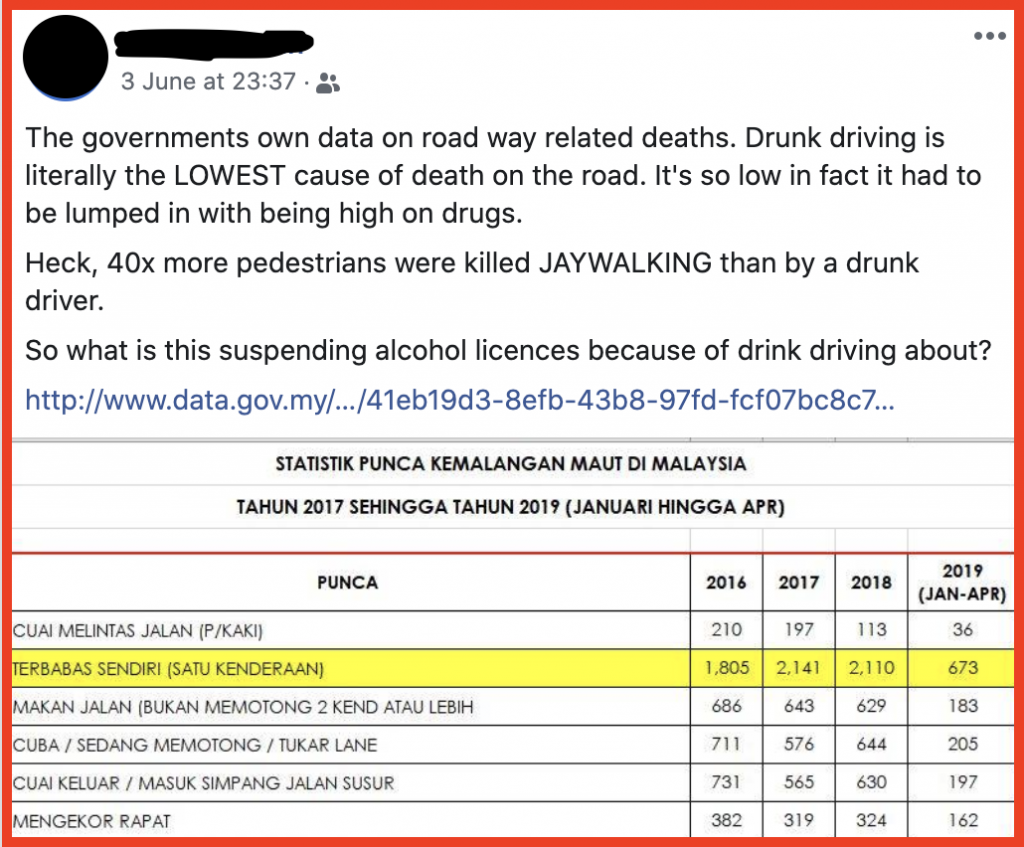
So if they’re legit, these numbers could potentially make or break many arguments concerning a nationwide ban on alcohol. And one good place to start when looking for legitimacy is the source of the information. Well…
These numbers came from the Home Ministry (!)

The screenshots being shared are taken from files uploaded on the Open Data Portal, which is exactly what the name implies – a portal that houses open data from the government. No fancy-shmancy MyData or 1Portal here folks! It was developed by MAMPU, the department in charge of modernizing the public sector, which is itself under the Prime Minister’s Department.
Pretty legit so far.
After a little bit of digging through the Open Data Portal, we found a list that’s even more extensive than the one in the screenshot; in a table that contains stats from 2011 to the whole of 2019. And, sure enough, drunk driving is the lowest contributor to fatal car accidents (except for a handful of years where it was the second lowest) :
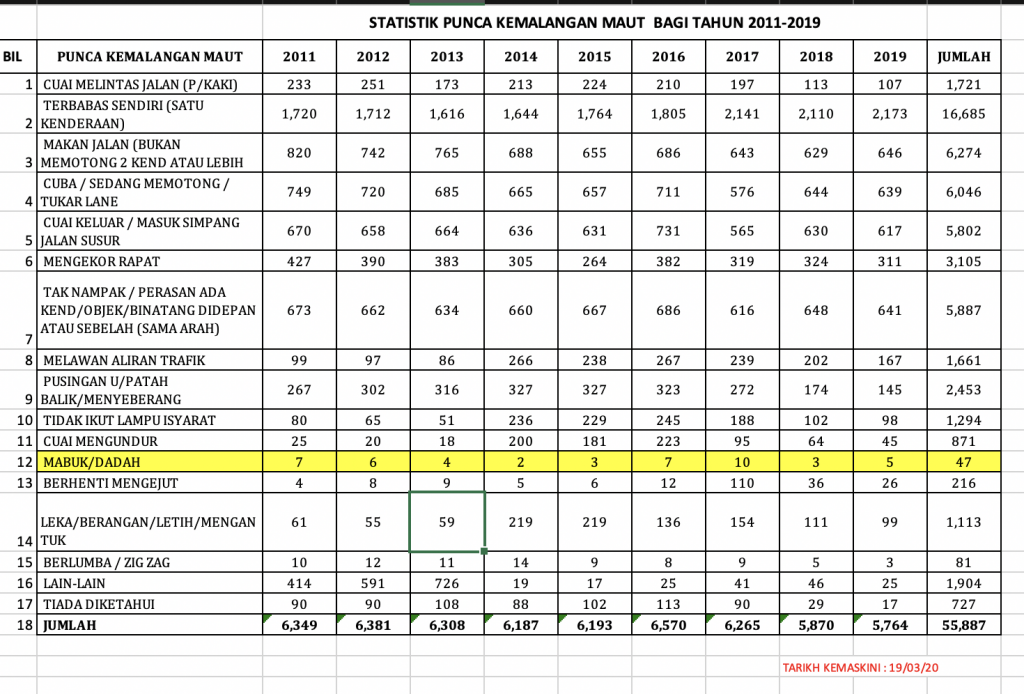
Not just that, this data was uploaded by the Home Ministry, listing the PDRM as the source. It’s not outdated or forgotten information either… it was last updated on March 19, 2020.
All these separate details come together for a perfectly legitimate cocktail mocktail of credibility but, out of itchiness, we went and did a little digging elsewhere just to, y’know, be sure.
And problems (such as having to rewrite this article) start when you don’t take things at face value, because…
The Transport Ministry and PDRM reported HIGHER numbers (!!!)

We came across two articles, one from The Asean Post and another from The Mole which put together graphs that contained much higher numbers. As perspective, the deaths from 2010 alone (49) numbered more than the entire 9 year period (47) reported in the Home Ministry’s data. We’re putting up the chart from The Asean Post, since both sites reported the same numbers. Again, both sites reported the SAME numbers.

Although The Mole listed their source as “Road crashes data obtained by The Mole in the past nine years,” The Asean Post listed their source as the United Nations Economic and Social Commission for Asia and the Pacific (UNESCAP), and it was here that we found the source of these stats : A table from a Powerpoint presentation prepared by a representative from the Ministry of Transport, which also (very helpfully) calculated the percentage of drunk driving fatalities for us.
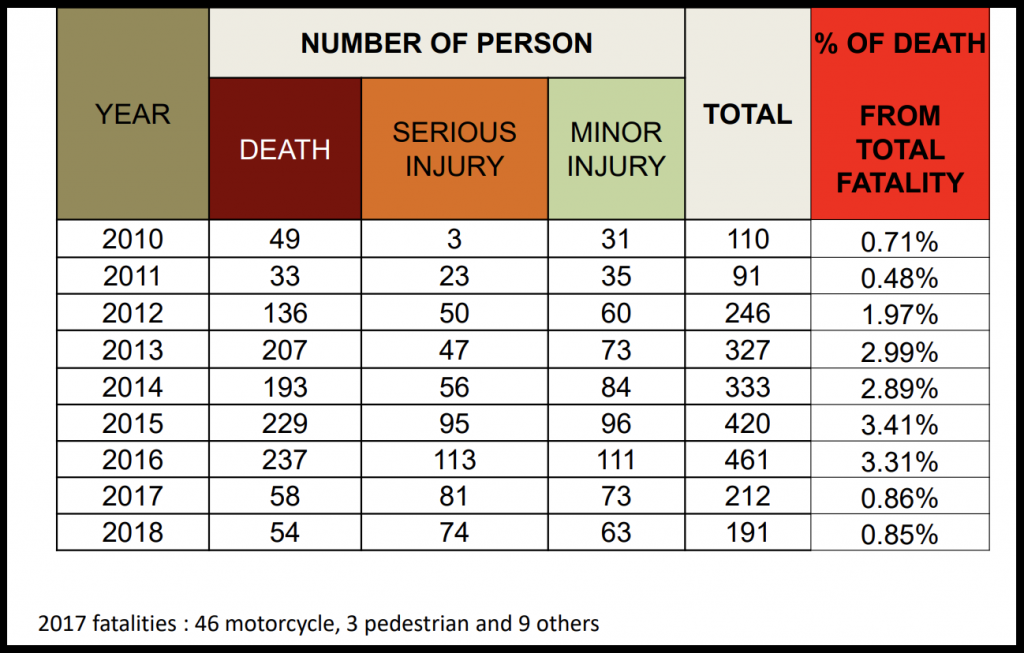
Not just that, when a PDRM spokesperson cited drunk driving fatality numbers in 2014, she gave the number as 193…. the same as the MOT presentation. This means that the numbers from this source look pretty legit as well, which leads to the problem of So which one to believe??? The super low numbers from the Home Ministry? or the high ones from UNESCAP??
Well, whichever you go with, there’s one fact that’s largely UNESCAP-able….
The numbers aren’t as high as you might think

We don’t know why the numbers differ so much, as there isn’t enough context from either source to provide any educated guesses.
But the point of the matter is that, even if we took the UNESCAP numbers, drunk driving still amounts to less than 5% of fatalities on Malaysian roads in any given year. The proportion of drunk driving accidents in total are also low when compared to the overall number of accidents (450k – 570k per year). We’re not gonna make a table for this because we want to be like a restaurant in the CMCO and not have too many open tables, but here’s the data if you wanna make your own.
The other question now is, if the numbers are so low, why does it seem like there’s a spike in drunk driving incidents? Well, there are at least a couple of ways to explain it:
The first is the Baader-Meinhoff phenomenon, where something appears to happen more frequently not because because it actually does, but because you’re noticing it more. For example, you might buy a MacBook for the first time and suddenly start noticing that there are a LOT of MacBook users. It’s not because Apple’s market share grew overnight, but because you’re subconsciously giving more attention to people with MacBooks – also called a frequency illusion.
The other is moral panic, which is an irrational fear that something seen as immoral (alcohol consumption in this case) would bring about devastating consequences to society. This then snowballs into enough public outrage that becomes the basis to push for changes in laws or policies.
Both these theories would make sense when you consider that the media tends to cover issues that the public are talking about, so it becomes a vicious cycle :
Drunk driving is a talking point ↔ media reports every single drunk driving incident → OMG every driver is more high than the amount of #pdrm and #mcmc complaints we’re going to get for this article.
Before it looks like we’ve somehow become advocates for drunk driving…
Drunk driving is still dangerous, and irresponsible

Saying that the numbers are low doesn’t mean that we shouldn’t care about drunk driving. It’s still something that could lead to serious consequences; not just from a legal perspective but also from its effect on victims and their families. What makes it worse is that drunk driving is a choice, considering that e-hailing services are readily available.
However, the low numbers might indicate that the focus on drunk driving may, at best, only result in marginally safer roads for everyone since – if we were to follow the categorization used by the Home Ministry – the greater majority of auto accidents are the result of pure carelessness or irresponsibility. At worst, it’s wasting time and resources on fixing a bogeyman problem while ignoring the actual root causes.
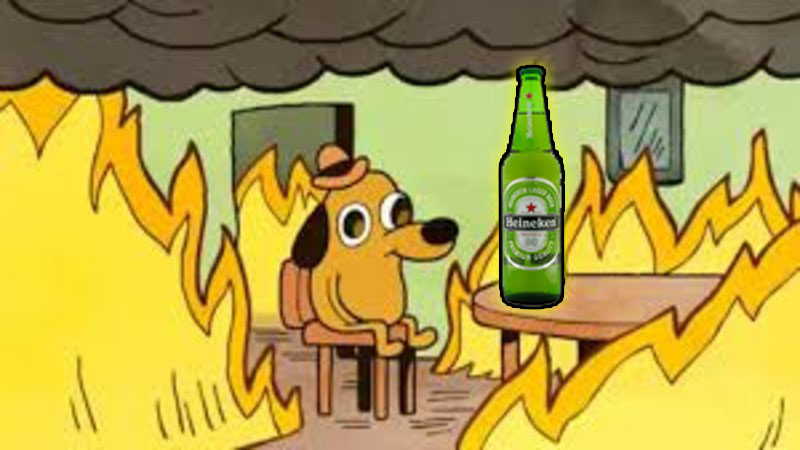
Not just that, history has also given a case study of what happens when a country suddenly bans alcohol… even for a short while. Back in the 1920’s, women’s and religious movements convinced the US government that alcohol was the source of all social ills, and so started a nationwide ban that became known as Prohibition. In fact, some towns were so convinced that Prohibition would stop crime that they actually sold their jails. However, what happened was the opposite – Prohibition resulted in more deaths, crime, dangerous moonshine, corruption, and the rise of organized crime in America.
So perhaps the solution is something that’s easy to say but hard to do – better laws and driver education across the board. In fact, the World Health Organization’s framework to reduce road accidents revolve around these 6 principles:
- Managing speed limits and laws
- Educating the public and drivers on road safety
- Improving road infrastucture
- Improving vehicle safety standards
- Creating and enforcing traffic laws
- Improving after-crash survival measures
As they say, education starts with yourself, so perhaps it’s best for drinkers to always keep in mind that a Bloody Mary should always refer to a cocktail and never the physical condition of their passenger.
- 15.1KShares
- Facebook15.0K
- Twitter12
- LinkedIn10
- Email40
- WhatsApp103


